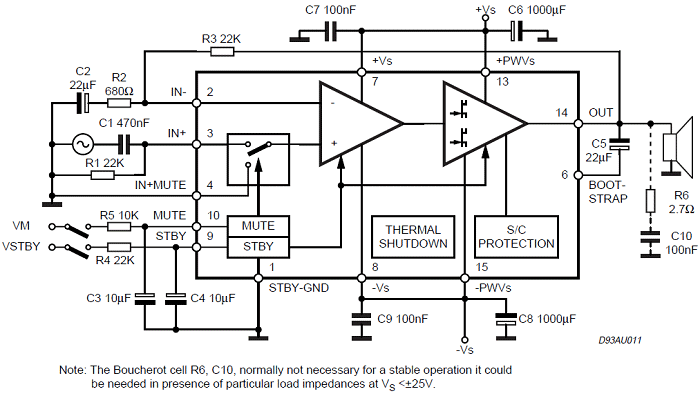TDA7294 is a monolithic class AB audio amplifier with a DMOS output stage. Firstly, it is used in Hi-Fi field applications for amplification of audio signals which includes self-powered loudspeakers, TV, etc. Secondly, it has its own fault protection circuitry against short-circuits and provides a thermal shutdown. Moreover, it has a wide voltage supply range and even in poor voltage regulation, it is able to drive loads of 4Ω and 8Ω. This integrated circuit is available in multi watt 15V and 15H packages.
TDA7294 Pinout Diagram
Pin Configuration Description
This 100 volt and 100-watt audio amplifier has 15 pins. The above pinout diagram shows the pin assignment.
Pin#01: Stand-by-GND
The output pin connects to ground.
Pin:02, 03: Inverting input, Non-inverting input
These two are input pins of the audio amplifier.
Pin#04: SVR
Supply voltage rejection pin suppresses the variations and remove noise from output signal.
Pin#05, 11, 12: NC
Not connected pins
Pin#06: Bootstrap
Bootstrap pin increases the output swing by connecting a capacitor at this pin.
Pin#07, 08: -, +
Connect these two pins to the positive and negative leads of voltage supply.
Pin#09: Stand by
It runs output in a low current mode.
Pin#10: Mute
It disables the output signal.
Pin#13: 15: -, + power supply
These are power supply terminals
Pin#14: Out
This pin provides an amplified sound signal.
Features
The features of TDA7294 are listed below:
- High operating voltage range of +40V to -40V with a DMOS output stage.
- Low noise and low distortion.
- The output power is very high up to 100W.
- Built-in protection against short circuit and thermal shutdown.
- It has additional functions of mute and stand-by.
- The maximum peak current at the output is 10A.
- Open-loop gain is 80dB.
- The threshold voltage for Standby ON is 1.5V and standby OFF is 3.5V.
Equivalent and Alternative Audio Amplifiers
Where to use it?
We need power amplifiers to get perfect bass sound for driving high power subwoofer loudspeaker. In such applications, the TDA7294 IC is used. It can give a power of up to 100 watts at the output and can be easily connected with a heat sink. You can use this IC in amplification circuits where the main requirement is high power and high efficiency.
How to use TDA7294?
TDA7294 IC has a mute function and stand by function. These functions simplify the operation of the IC by avoiding noises produced as a result of switching. The mute function allows the IC to mute the output. The pin10 value should be less than 1.5V. When the voltage at pin10 is greater than 3.5V, the outputs will go into the mute mode. It has four power supply pins. Pins7 and 8 supply power to the signal part. Pins13 and 15 are for the power part of the circuit. These four pins are provided to ensure highly efficient operation.
Circuit Example
A subwoofer amplifier circuit designed using TDA7294 IC is given below.
We have used an 8Ω speaker. Standby and mute functions are not used that’s why these pins are floating. It has two input pins. An input signal is applied at the non-inverting pin to obtain an in-phase output signal. To control volume, connect a variable resistor or potentiometer at the non-inverting pin.
600Watts R.M.S – Subwoofer Amplifier – TDA7294 X 6
How to Change Volume?
By changing the resistance of that potentiometer, you can increase or decrease the volume of output sound signal. Power the IC through pin 13 and pin 15. After switching ON the supply, you’ll obtain an amplified signal at pin 14 which can be heard from a speaker connected at this pin.
TDA7294 IC Applications
It is used in audio applications like:
- Self-powered loudspeakers
- Radio
- Subwoofers and home stereo systems
- TV
- Bridge circuits
2D Diagram
The two-dimensional diagram for its multi watt 15V package is given. For other packages, check the datasheet.




